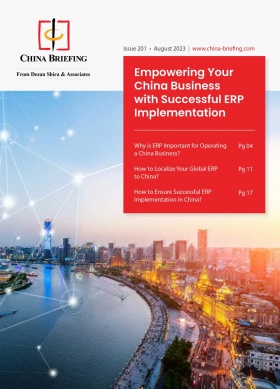Industrial Internet in China: How Policies Enable Latest Stage of Industry 4.0
The Industrial Internet in China is viewed as a critical tool to foster technological advancements and high-end manufacturing. It has played a pivotal role in enhancing the output across the primary, secondary, and tertiary sectors of the economy. We discuss the state policies that seek to strategically foster innovative growth across all sectors of the Chinese economy and their appeal to foreign companies as well.
The “Industrial Internet” is considered by the Chinese government as one of the key tools to support various types of businesses, including both state-owned enterprises and private businesses, towards achieving major technological breakthroughs and the development of high-end manufacturing. This is demonstrated in official documents released by state-level ministries, such as the National Development and Reform Committee (NDRC) and the Ministry of Industry and Information Technology (MIIT).
In this article, we delve into the origin and development of the Industrial Internet in China, examine the country’s strategies and initiatives for promoting it among businesses, and explore the opportunities and challenges for foreign enterprises in light of these emerging trends.
What is the Industrial Internet?
The Industrial Internet refers to the convergence of industrial systems with advanced computing, data analytics, sensory technologies, and internet-enabled connectivity. It is the application and development of new-generation information technology in the industrial sector that provides a viable path for the digital transformation of businesses.
In contrast to consumer internet applications like online shopping, food delivery, and ride-hailing, which cater to individuals, Industrial Internet applications are found in smart factories, warehouses, and ports. The Industrial Internet combines IT capability with operational technology, thereby elevating the productivity, efficiency, and dependability of industrial manufacturing processes.
The term “Industrial Internet” was first defined by Boston-based General Electric in 2012. Since then, numerous countries have introduced industrial upgrade blueprints aimed at enhancing productivity through the adoption of new technologies. For instance, Germany launched its “Industry 4.0” plan in 2013, and in 2015, Beijing unveiled its strategic initiative known as “Made in China 2025.” This movement has created a competitive landscape among the world’s leading economies vying for a dominant position.
With rapid technology development, the Industrial Internet is quickly extending its influence into various non-manufacturing sectors, including healthcare, education, transportation, and insurance. Its applications cover a spectrum of industrial scenarios, encompassing visual quality inspection, intelligent warehousing, quality traceability, intelligent production scheduling, lean production, process optimization, and equipment fault diagnosis and prediction.
What is the market size and scale of China’s Industrial Internet?
China’s Industrial Internet has achieved remarkable scale in recent years, reaching over RMB 1.2 trillion (US$167.7 billion) in value in 2023, according to the China Academy of Industrial Internet (CAII). Notably, the added value of China’s Industrial Internet industry in 2022 witnessed an impressive 8.7 percent year-on-year growth, soaring to RMB 4.45 trillion (US$640 billion) compared to the previous year, and constituting 3.64 percent of the GDP.
The Industrial Internet in China has played a pivotal role in enhancing the output across the primary, secondary, and tertiary sectors of the economy.
China’s Industrial Internet ecosystem encompasses over 100 Industrial Internet platforms, seamlessly connecting with a vast network of 76 million machines. The country now leads the world with more than 1,500 “5G + Industrial Internet” projects. China has nurtured 240 influential Industrial Internet platforms, with 28 of them showcasing cross-industry and cross-domain capabilities.
A significant milestone has been the establishment of a comprehensive identification and analysis system for the Industrial Internet, spanning 31 provincial-level regions and serving an extensive network of more than 260,000 enterprises. The MIIT highlights the remarkable expansion of the Alliance of Industrial Internet, which has drawn over 2,500 members from both domestic and international backgrounds, representing 80 diverse industries. Furthermore, this has also contributed to the transformation of China’s employment structure, promoting employment stability and potentially creating more than 1 million new jobs in the current year.
China’s digital transformation success stories include SANY Group, a heavy equipment manufacturer that built a digital network for its manufacturing facilities, connecting 17,000 operational equipment and greatly improving their operation efficiency. Inspur Group, a cloud computing and big data provider, facilitated digital upgrades in industries like rubber and steel. In collaboration, Huawei and Tianjin Port Group created the world’s first “zero-carbon port terminal,” utilizing robots and remotely-controlled cranes. In a 5,400-square-meter workshop in Jinan, Shandong Province, automated guided vehicles reduced the need for human workers to just 39, using Inspur Yunzhou’s Industrial Internet platform.
Understanding China’s policy initiatives in promoting the Industrial Internet
China’s top industry regulator announced plans to introduce new policies aimed at accelerating the progress of the Industrial Internet, a key stage of the fourth industrial revolution. This year, 2023, marks the completion of the three-year strategic blueprint set by the MIIT to foster innovative growth in the Industrial Internet. As part of this agenda, the MIIT has been encouraging the establishment of 5G-powered factories and the development of upgraded versions of “5G plus industrial internet” projects.
In June 2023, the MIIT released another one-year work plan for Industrial Internet development, which aims to drive forward digital upgrading across the manufacturing sector in 2023.
In July 2023, in the task list jointly released by the NDRC and seven other ministries on boosting China’s private sector, “supporting private enterprises to participate in major technological breakthroughs, and take the lead in undertaking research tasks in fields such as industrial software, cloud computing, artificial intelligence, industrial internet, genetic and cellular medicine, and new energy storage” was listed as one of the 28 items for improving business environment for private firms.
Zhang Yunming, Vice-Minister of MIIT, emphasized during a speech at the 2023 Industrial Internet Conference in Suzhou, Jiangsu province, that the Industrial Internet serves as a fundamental cornerstone for the seamless integration of the digital economy and the real economy. He emphasized the importance of adhering to strategic guidance, enhancing the policy framework for innovation and development in the Industrial Internet sector in the new era, and actively formulating guidelines to propel high-quality development in this field. At the conference, Zhang also called upon local governments to foster closer collaboration with the MIIT, bolstering policy coordination and fuel innovation.
On September 12, 2023, China’s Industrial Internet Research Institute released 11 new standards, including the “National Industrial Internet Big Data Center System Industry Chain Coding Specification” and “National Industrial Internet Big Data Center System Enterprise Qualification Database Data Standard and Sharing Interface Specification.” These standards aim to simplify data integration, improve quality, and enhance efficiency, laying the foundation for a unified data system. Rolled out as the third batch, they also form a broader standard framework, entailing seven sections: fundamental concepts, infrastructure development, data Lake and 1+N thematic library, shared interchange, data Organization, data security, and industry applications. The Industrial Internet Research Institute pledges to keep updating standards in line with evolving business needs.
Moreover, the Industrial Internet is a crucial part of ‘industrial digitalization’, which was listed as one of the key goals of the ‘new type industrialization’ (NTI) promoted in President Xi Jinping’s speech on September 23.
China’s recent initiatives to advance the Industrial Internet’s development are poised to inject fresh vitality into the convergence of advanced manufacturing and digital technologies, supporting the country’s vast industrial economy amid prevailing challenges and uncertainties. Experts and corporate leaders emphasize the importance of reinforcing the development of industrial central processing units and focusing on critical technologies like AI and industrial software. A multitude of sectors, including aerospace, equipment manufacturing, electronics, chemicals, mining, steel production, energy, and food, have already embarked on digital transformation journeys by embracing the Industrial Internet.
What are the challenges?
Despite enjoying robust policy support, China’s Industrial Internet faces a series of interconnected challenges. The multifaceted character of the Industrial Internet necessitates diverse and sustained improvements to bridge the gap between offerings and industry-specific needs. Technology advances may also create new complexities that require ceaseless exploration.
These developments also come at a time of uncertainties, and following a three-year regulatory crackdown on consumer internet companies over concerns such as data practices and market monopolies. Some concerns have faded away with the crackdown abating, but the government has also promulgated a series of regulations focusing on information protection and privacy. At the same time, competition and sanctions from the United States may add further challenges to the path ahead.
Further, as foreign investments in China’s internet sectors decline due to rising global isolationism and protectionism, the nation is increasingly dependent on domestic funding to drive its digitalization initiatives. This shift underscores the changing dynamics and focal points within China’s digital economy. Importantly, this turn coincides with a period of economic vulnerability for China, as demonstrated by the key economic indicators released by the National Bureau of Statistics in the past few months. Securing the ability to rejuvenate the economy following the impact of a protracted COVID-19 pandemic and amid great power competition will be critical.
How foreign companies can take part in the Industrial Internet sector in China?
Actively attracting and effectively utilizing foreign investment is a significant component of China’s strategy to promote high-level openness and upgrade its economy. The State Council’s “Opinions on Further Optimizing the Foreign Investment Environment and Strengthening Efforts to Attract Foreign Investment” on August 13 introduced comprehensive policies and measures aimed at enhancing the quality of foreign investment utilization, ensuring national treatment for foreign-invested enterprises, bolstering foreign investment protection, increasing investment and operational facilitation, and providing greater financial and tax support. These steps collectively aim to foster a more robust and attractive environment for foreign investment in China.
The Industrial Internet is an umbrella concept covering a wide range of different sectors and investment areas. Foreign companies can actively engage in China’s burgeoning Industrial Internet sector by adopting a multifaceted approach. In this regard, we advise investors and business partners to reference the latest Special Administrative Measures (Negative List) for Foreign Investment Access and the Catalogue of Encouraged Industries for Foreign Investment. To mitigate potential risks, tailoring solutions to meet specific Chinese industry needs and conforming to local standards, including cybersecurity and data privacy, is essential.
About Us
China Briefing is written and produced by Dezan Shira & Associates. The practice assists foreign investors into China and has done so since 1992 through offices in Beijing, Tianjin, Dalian, Qingdao, Shanghai, Hangzhou, Ningbo, Suzhou, Guangzhou, Dongguan, Zhongshan, Shenzhen, and Hong Kong. Please contact the firm for assistance in China at china@dezshira.com.
Dezan Shira & Associates has offices in Vietnam, Indonesia, Singapore, United States, Germany, Italy, India, Dubai (UAE), and Russia, in addition to our trade research facilities along the Belt & Road Initiative. We also have partner firms assisting foreign investors in The Philippines, Malaysia, Thailand, Bangladesh.
- Previous Article Calculators for Registered Capital and Total Investment in China
- Next Article China Releases New Data Series on Service Retail Sales







